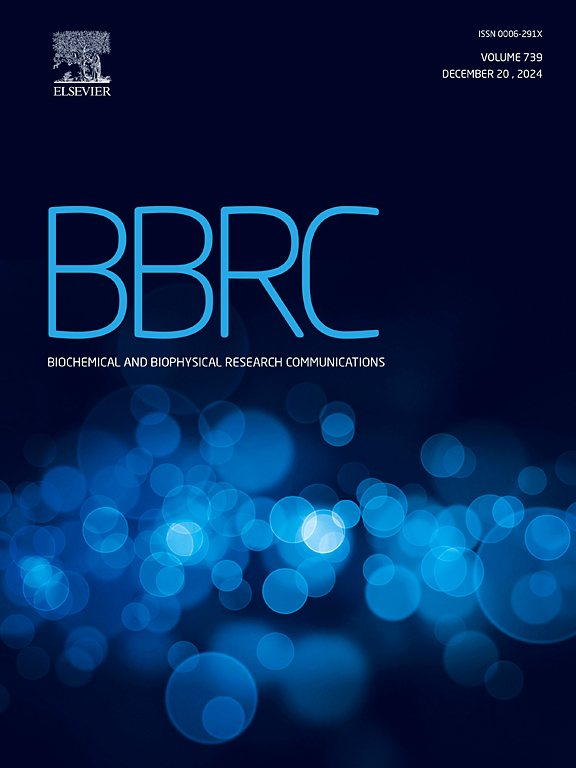Identification of the binding site and immunoreactivity of anti-Aβ antibody 11A1: Comparison with the toxic conformation-specific TxCo-1 antibody
IF 2.5
3区 生物学
Q3 BIOCHEMISTRY & MOLECULAR BIOLOGY
Biochemical and biophysical research communications
Pub Date : 2025-03-17
DOI:10.1016/j.bbrc.2025.151655
引用次数: 0
Abstract
Since the advent of anti-amyloid β (Aβ) immunotherapy, exemplified by lecanemab, the development of effective therapeutic agents with minimal side effects has become an urgent priority. Over the past two decades, a number of antibodies have been developed that target toxic Aβ species. The 11A1 antibody is one such example, and is made from E22P-Aβ9–35, which is prone to adopt a toxic conformation with a turn at positions 22/23, as an antigen. This antibody is unique in that it stains not only extracellular but also intracellular Aβ in human AD brains. To identify its recognition domain, we performed X-ray crystallography of 11A1 in complex with E22P-Aβ10–34. We found that 11A1 is a novel N-terminal antibody that recognizes Tyr10–His14 of Aβ. Immunohistochemical studies showed that 11A1 stains senile plaques and vascular Aβ aggregates in brain samples of AD patients. On the other hand, 11A1 recognized Aβ aggregates in neurons, astrocytes, perivascular tissue, and microvesicles of non-AD patients, suggesting that 11A1 can detect a wide range of Aβ types regardless of AD pathology. In contrast, the recently developed TxCo-1 antibody, which specifically recognizes the toxic turn at positions 22/23 of Aβ42, stained only senile plaques and vascular Aβ aggregates from AD patients, but not Aβ species from non-AD patients. These results suggest that the toxic turn structure may be one of the key epitopes for achieving high affinity for pathological Aβ aggregates while minimizing nonspecific binding to aggregates unrelated to pathology.

自从以莱卡尼单抗(lecanemab)为代表的抗淀粉样蛋白β(Aβ)免疫疗法问世以来,开发副作用最小的有效治疗药物已成为当务之急。在过去的二十年里,已经开发出了许多针对有毒 Aβ 物种的抗体。11A1 抗体就是这样一个例子,它是以 E22P-Aβ9-35 为抗原制成的,E22P-Aβ9-35 容易在 22/23 位发生转折而形成毒性构象。该抗体的独特之处在于,它不仅能染色细胞外,还能染色人 AD 大脑中细胞内的 Aβ。为了确定其识别域,我们对 11A1 与 E22P-Aβ10-34 的复合物进行了 X 射线晶体学分析。我们发现,11A1是一种新型的N端抗体,能识别Aβ的Tyr10-His14。免疫组化研究显示,11A1能染色AD患者脑样本中的老年斑和血管Aβ聚集体。另一方面,11A1 也能识别非 AD 患者的神经元、星形胶质细胞、血管周围组织和微囊中的 Aβ 聚集,这表明 11A1 可以检测多种 Aβ 类型,而与 AD 的病理类型无关。与此相反,最近开发的 TxCo-1 抗体能特异性识别 Aβ42 第 22/23 位的毒性转折,该抗体只对 AD 患者的老年斑和血管 Aβ 聚集体染色,而对非 AD 患者的 Aβ 物种不染色。这些结果表明,毒性转折结构可能是实现对病理性 Aβ 聚集体高亲和力的关键表位之一,同时可将与病理无关的聚集体的非特异性结合降至最低。
本文章由计算机程序翻译,如有差异,请以英文原文为准。
求助全文
约1分钟内获得全文
求助全文
来源期刊
CiteScore
6.10
自引率
0.00%
发文量
1400
审稿时长
14 days
期刊介绍:
Biochemical and Biophysical Research Communications is the premier international journal devoted to the very rapid dissemination of timely and significant experimental results in diverse fields of biological research. The development of the "Breakthroughs and Views" section brings the minireview format to the journal, and issues often contain collections of special interest manuscripts. BBRC is published weekly (52 issues/year).Research Areas now include: Biochemistry; biophysics; cell biology; developmental biology; immunology
; molecular biology; neurobiology; plant biology and proteomics

 求助内容:
求助内容: 应助结果提醒方式:
应助结果提醒方式:


